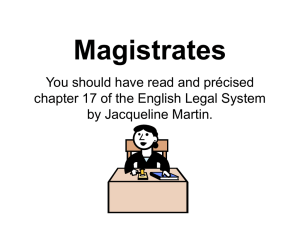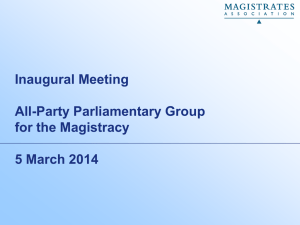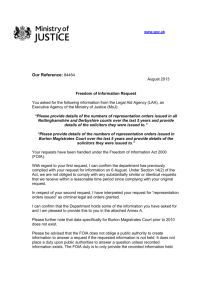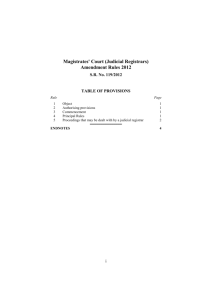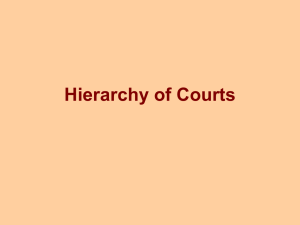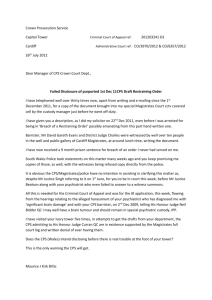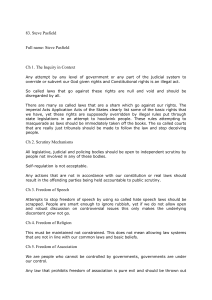TFH van Rooyen and Two Others v The State and Six Others
advertisement
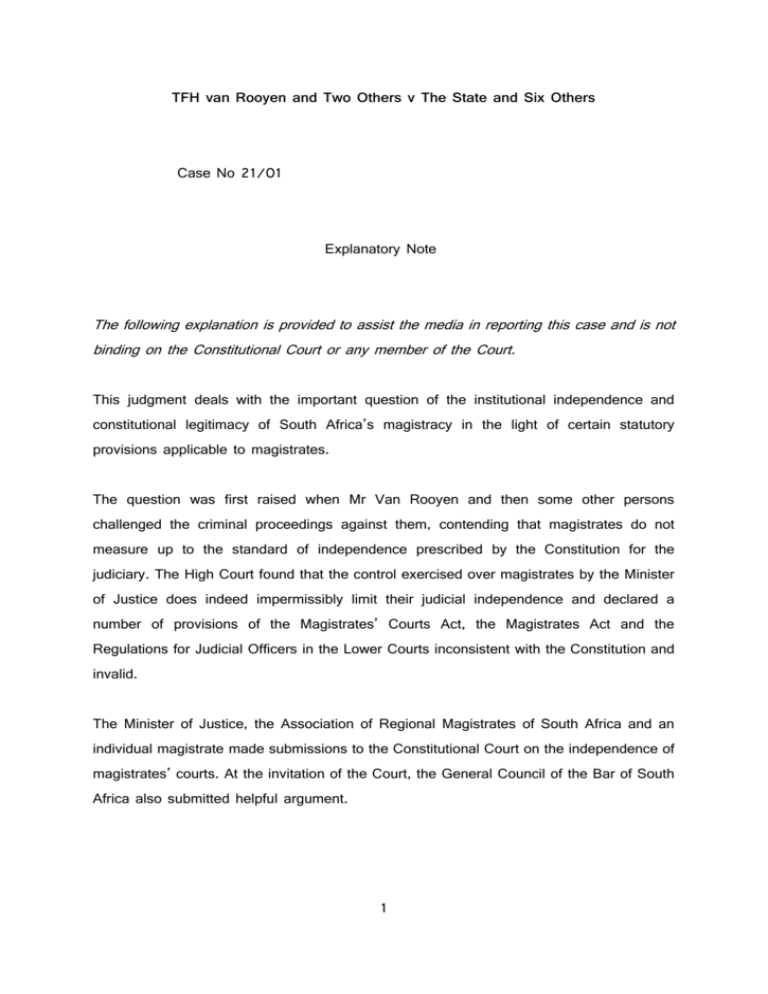
TFH van Rooyen and Two Others v The State and Six Others Case No 21/01 Explanatory Note The following explanation is provided to assist the media in reporting this case and is not binding on the Constitutional Court or any member of the Court. This judgment deals with the important question of the institutional independence and constitutional legitimacy of South Africa’s magistracy in the light of certain statutory provisions applicable to magistrates. The question was first raised when Mr Van Rooyen and then some other persons challenged the criminal proceedings against them, contending that magistrates do not measure up to the standard of independence prescribed by the Constitution for the judiciary. The High Court found that the control exercised over magistrates by the Minister of Justice does indeed impermissibly limit their judicial independence and declared a number of provisions of the Magistrates’ Courts Act, the Magistrates Act and the Regulations for Judicial Officers in the Lower Courts inconsistent with the Constitution and invalid. The Minister of Justice, the Association of Regional Magistrates of South Africa and an individual magistrate made submissions to the Constitutional Court on the independence of magistrates’ courts. At the invitation of the Court, the General Council of the Bar of South Africa also submitted helpful argument. 1 This judgment, written by Chief Justice Chaskalson for a unanimous Court, first discusses the principle of judicial independence in a constitutional democracy such as ours which recognises the doctrine of separation of powers. This is followed by an analysis of the composition, powers and duties of the Magistrates Commission, a body established under the Magistrates Act to play a major role in the control and supervision of the magistracy. Finally, the judgment examines each of the enactments that were struck down by the High Court and the reasons given by that Court for their invalidation. In most instances the findings of the High Court are set aside; in some instances its orders are adapted and some of its invalidation orders are confirmed. The Constitutional Court finds that the core of judicial independence is the complete freedom of individual judicial officers to hear and decide the cases that come before them – with no outside interference or attempt to interfere with the way in which judicial officers conduct their cases and make their decisions. Individually judicial officers must be free to act independently and impartially in dealing with the cases they hear and, at an institutional level, there must be structures to protect courts and judicial officers against external interference. These safeguards must include security of tenure and a basic degree of financial security. In deciding whether a particular court lacks the institutional protection that it requires to function independently and impartially, it is relevant to have regard to the core protection given to all courts by our Constitution, to the functions that the particular court performs and to its place in the court hierarchy. Lower courts are, for instance, entitled to protection by the higher courts should their independence be threatened. The greater the protection given to the higher courts, the greater is the protection that all courts have. Judicial independence can be achieved in a variety of ways and the mere fact that the legislation dealing with lower courts differs from the Constitution’s provision for higher courts is no reason for holding it to be unconstitutional. The test for assessing whether the requirements for judicial independence have been satisfied includes an element of appearance or perception – whether the courts are independent in the eyes of the notional reasonable, well-informed, thoughtful observer. The 2 Court stresses that in our country, this observer must be sensitive to the country’s complex social realities, in touch with its evolving patterns of constitutional development and guided by the Constitution, its values and the distinction it draws between different courts. The constitutionality of many of the challenged provisions depends on whether the Magistrates Commission is an independent body or subject to control by the Minister. The Commission must be chaired by a High Court judge and must include magistrates, lawyers in private practice and parliamentarians. The Commission’s objectives include ensuring that the appointment, promotion, transfer or discharge of, or disciplinary steps against, magistrates take place without favour or prejudice and that no influencing or victimisation of magistrates takes place. Therefore, although the executive influences the selection of the Commission’s members, this body is an important safeguard of judicial independence. There is no reason to believe that its members will not discharge their duties with integrity. Moreover, the composition of the Commission resembles that of the Judicial Service Commission, which was created by the Constitution itself. There are also powerful constitutional and judicial safeguards in place to prevent interference with the Commission by the executive or the legislature. The Magistrates Commission can and must play an important part in protecting judicial independence regarding the appointment of magistrates, their salaries, promotion, duties, disciplining and removal. Some of the specific provisions relating to the assignment of certain powers to magistrates and their removal from office that were struck down by the High Court are found to be inconsistent with the Constitution as they stand, but these objections are met by declaring unconstitutional and excising only the offending parts of the provisions. With regard to the appointment of magistrates, the Court finds that the mere fact that the executive and the legislature participate in the appointment process is not inconsistent with judicial independence. The Constitution itself allows for the executive and the legislature to participate in the appointment of judges and this approach is followed by various other constitutional democracies, including the United States, Germany and Australia. Likewise, there can be no constitutional objection to the appointment of acting or temporary 3 magistrates for practical reasons although these appointees should not hold office at the discretion of the executive. As regards removal of magistrates, the grounds prescribed by the Magistrates Act are similar to those for the removal of judges in countries such as Australia, Canada, New Zealand and the United Kingdom. In any event, similar grounds are given in the Constitution for removal of the Public Protector, the Auditor-General and members of the Human Rights Commission, the Commission on Gender Equality and the Electoral Commission. An investigation for the removal of magistrates should, however, not be initiated by the Minister nor conducted by ministerial appointees. That role should be vested in the Commission with the final decision as to removal vesting in Parliament. With regard to fixing magistrates’ salaries, the Magistrates Commission is an independent intermediary between magistrates and the legislature and the executive. Magistrates’ salaries can be reduced by Parliament only and such reduction must be justifiable, otherwise it can be set aside by the higher judiciary as inconsistent with judicial independence. In the context of the protection given to magistrates’ courts and magistrates at an institutional level by the Constitution itself and by the other safeguards referred to in the judgment, the legislation viewed as a whole is consistent with the core values of judicial independence. There is no reason to believe that magistrates will not administer justice, as they have done in the past, impartially, independently and in accordance with the law. Any attempt to interfere improperly with the way that a magistrate conducts or decides a particular case can be remedied there and then by the magistrate or, if necessary, by a higher court. Finally, the Court supports the High Court’s dismissal of the applications to set aside the criminal proceedings in the magistrates’ courts that initiated the case. Those courts are independent and free to do their judicial duty. 4
